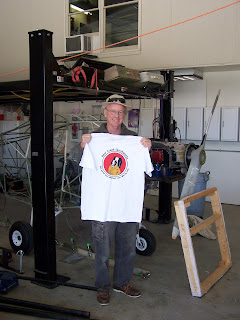Yesterday saw nine people hard at work at the Skunk Works from 9-7. The left wing and rudder were covered, and it is clear that our skills are improving. The images below show this.
What's next? The newly-covered surfaces will receive a coat of PolyBrush to seal the fabric. Next, we'll be learning the fine art of rib-stitching, which will take quite a bit of time and is one of the more critical parts of homebuilding that must be done 100%, or not at all.
Once the rib-stitching is done, the covered surfaced will receive a few coats of UV-blocking silver paint, then they'll be hoisted into the rafters until the spring. Attention will then switch to the many tasks remaining on the engine and fuselage. We're now 80% done, with 80% to go!

Nathan and Andy make a few final touches to the wing before covering.

Andy applies a coat of PolyBrush to all surfaces where the fabric will be attached.

Al and Terry plan the procedure to attach cloth to the lower surface. We started by gluing it to the trailing edge, then gluing to the leading edge and onto the stringers just below the aluminum leading edge. This way, the only seam that shows is on the under surface.

Much of the process requires the help of 3-4 people. Here Terry holds cardboard under the brush to prevent spillage onto the clean fabric. Paul and Al hold the fabric in position while Joel carefully "paints" a one inch stripe of PolyTack.

The wing root and wing tip pose the greatest challenges. Here, Paul assists Terry in the cutting and placement of the ends of cloth around corners.

Before using them, irons must be accurately calibrated. Terry demonstrates how this is done.

When we finally started shrinking the cloth - the best part of covering - all of the hard work was over. As Joel shrinks the fabric on the underside of the wing, Chris, Al and Nathan enjoy the magic.

Al takes a turn at shrinking the fabric, first at 250 degrees then at the final setting of 350 degrees.

Nathan, who will be leaving us soon for A&P school in Portland, Oregon, became quite proficient at the iron. This will come in handy for this bachelor!

While most worked on the left wing, Konrad and Andy covered the rudder. While the overall size of the part was small, it was quite complicated due to the small size of tubing, sharp curvature and several tabs to negotiate.
Below: Proud of our work, we took a short field trip to Chris McClure's Husky to see how the pros cover an airplane. It was obvious that we have much to learn!











































